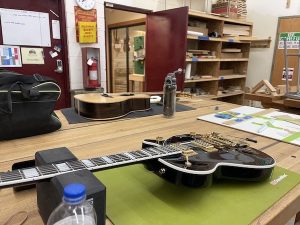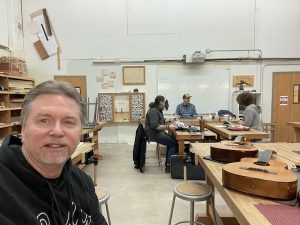I took a break over the holidays and before you know it, it’s February. There has been a lot going on since last fall.
 When I decided to record my journey of guitar repair, restoration, and eventually building my own guitars, I began to do a lot of research on these subjects. Growing my skills as a Luthier has been a dream for many years, but something always seemed to get in the way. While doing my research I found that the Red Rocks Community College in Colorado offered a Luthier Artisan certificate program that focuses on the very areas I was researching, I looked into the program and found it was affordable and would save me a lot of time and research.
When I decided to record my journey of guitar repair, restoration, and eventually building my own guitars, I began to do a lot of research on these subjects. Growing my skills as a Luthier has been a dream for many years, but something always seemed to get in the way. While doing my research I found that the Red Rocks Community College in Colorado offered a Luthier Artisan certificate program that focuses on the very areas I was researching, I looked into the program and found it was affordable and would save me a lot of time and research.
I registered for my first two classes, but they would not start until the middle of January. The classes I am taking this semester are Intro to  Woodworking and Guitar Setup and Repair. Each class is several hours long per day but is held only one day a week. While I have only been to a few classes I am learning quite a bit, which may have taken me a lot longer on my own. I am able to ask the questions as they come to me without having to research everything.
Woodworking and Guitar Setup and Repair. Each class is several hours long per day but is held only one day a week. While I have only been to a few classes I am learning quite a bit, which may have taken me a lot longer on my own. I am able to ask the questions as they come to me without having to research everything.
So now I am digging in deeper and laying a good foundation. By the time I finish in 2024 (yes 2024), I will be an old hand at guitar repair, but just as important I will have built an acoustic and electric guitar of my own. These classes will have us ordering kits to build, but at the same time, I will be working on building templates to build my own body and neck on my CNC router. This will provide a lot of flexibility and freedom to come up with custom designs.
 The pictures are from the woodworking and Guitar Repair classes. They keep the class size at around 12 people and the semester is 16 weeks long. In the woodworking class, I will learn about the properties of wood and how to work with them. We are also learning about many of the fine woodworking tools, along with how to prepare the wood and we are building a few small furniture projects. In the guitar setup and repair class, we will cover all that is involved with guitar setup, along with dealing with cracks, chips, and other types of damage. We will also work with hardware such as bridges, saddles, pickups, nuts, frets, and more.
The pictures are from the woodworking and Guitar Repair classes. They keep the class size at around 12 people and the semester is 16 weeks long. In the woodworking class, I will learn about the properties of wood and how to work with them. We are also learning about many of the fine woodworking tools, along with how to prepare the wood and we are building a few small furniture projects. In the guitar setup and repair class, we will cover all that is involved with guitar setup, along with dealing with cracks, chips, and other types of damage. We will also work with hardware such as bridges, saddles, pickups, nuts, frets, and more.
In both classes, the instructors are professionals that have been working in their respective fields for years. And while the classes are between 4 – 5 hours long (yes we get breaks), I find myself very engaged and asking a lot of questions. We also have one student in the guitar setup and repair class that has been doing guitar repair for a while, but it was based on informal (self-taught) learning. Some of the students with more experience mentioned during our introductions that they wanted to dig deeper as well and get some professional training. Which means I am in good company.
Now, my point to this article. I could have jumped right in and started recording my projects, but once I found a source for good instruction, I decided to slow down just a little and take in the information I am getting from my classes and then start my projects with a good foundation.
I am hoping to get my first repair project recorded in March, so it is coming soon.

